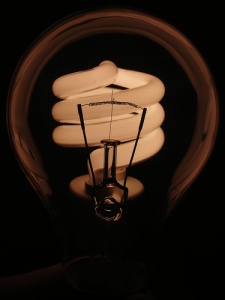Given the current state of the U.S. economy with a 9.7 % unemployment rate in January, it is uncertain when the recession will end. Americans have cut back, businesses have scaled down production and the once rapid growth of the U.S. economy has stumbled. In the midst of the current environmental movement, many people voice that given the recession, now is not the time to spend money on green infrastructure. This post will present a cost-benefit and economic analysis of building green. My goal for this post is to positively add to the decision making process of individuals and businesses contemplating to build, buy and design green.
 (Photo by Andre Movseyan/DeMaria Design)
(Photo by Andre Movseyan/DeMaria Design)
THE BENEFITS:
Positive Return on Investment
According to a recent study, green homes in the Pacific Northwest are outselling their competition in the real estate market. Green certified homes in Seattle sold for 8.5 % more per square foot and were on the market 22% less time than other homes in the same area. This study shows that building green can result in positive net benefits. The study focused on new home sales between September 2007 and December 2009. Despite the recession, it seems that building green certified homes resulted in positive returns to the seller. But, what does the buyer gain from purchasing a green home?
Since green certified homes sold for 8.5 % more than other homes, buyers greatly value the environmental benefits of certified homes. Homebuyers paid a premium for certified homes that encompass renewable energy, eco-friendly materials and energy efficiency. Buyers of green homes believe that the purchase is a healthy and environmentally responsible choice for their family and are willing to pay a premium for these benefits. The value- added non-market environmental benefits of a green certified home are reflected in the higher price.
Save Money on Energy Bill

Photo: Flickr.com
Green certified building use energy efficient lighting. Energy Star compact fluorescent light bulbs (CFLs) use 75 percent less energy and last 10 times longer than traditional light bulbs. In addition, CFLs save money. According to the U.S. Department of Energy, “One CFL will save about $30 over its lifetime and pay for itself in about 6 months.” There is proof that Americans use CFLs. The Sylvania Socket Survey discovered, “Almost three quarters (74%) say they have switched a light bulb for more energy efficiency in 2009.”
This is just one example of saving money through energy efficient green homes. Other ways to save are Energy Star appliances, water heaters, insulation, green roofs and windows. Check out the
Energy Star Savings Calculator.
Ultimately, green homes result in lower ownership costs.

Photo: Green Over Gray
Healthy Living
Green certification checklists, such as LEED incorporate building materials and finishes with low volatile organic compounds (VOCs). LEED stands for Leadership in Energy and Environmental Design. “LEED is an internationally recognized green building certification system, providing third-party verification that a building or community was designed and built using strategies aimed at improving performance across all the metrics that matter most: energy savings, water efficiency, CO2 emissions reduction, improved indoor environmental quality, and stewardship of resources and sensitivity to their impacts.”
According to the U.S. Environmental Protection (EPA), VOCs are emitted as gases from certain solids or liquids. VOCs include a variety of household chemicals that cause adverse health effects. VOCs are found in higher concentrations indoors than outdoors (up to ten times higher). Designing, building and buying a LEED certified house will guarantee that you will have less exposure to harmful VOCs. Ultimately, indoor air quality will be improved.

Photo: Flickr.com
Conserve Finite Resources and Climate Change
The picture above of the Redondo Beach home was made out of eight recycled steel shipping containers. Seventy percent of the building was efficiently assembled in a shop, saving time, money and resources.
LEED certified buildings incorporate recycled and renewable materials along with water conservation and energy efficiency design techniques. Choosing to incorporate Forest Stewardship Council (FSC) certified wood and recycled materials will help conserve the world’s finite resources, reduce deforestation and address climate change. Incorporating low flow shower heads, faucets and Energy Star dishwashers will conserve water. Energy efficient appliances, lighting, water heaters and insulation will help conserve energy and reduce the use of resources.
THE COSTS:
Price/Money/Funding
Green certified buildings have higher upfront fixed costs. The building materials in certified buildings are of higher quality, therefore cost more than conventional materials. Sustainable, renewable and low VOC materials have many environmental benefits and their value is reflected in the higher retail price. Energy efficient appliances usually cost more than conventional appliances, but the amount of energy savings over the lifetime of the appliance might actually be less for an energy efficient model.
The U.S. economy has struggled during this recession and many budgets are being scaled back. Less funding may be available to build green. Priorities are being reconsidered, and for many Americans, putting food on the table is a higher priority in the current economic climate. Currently, Americans might not value the environment as they once did in times of growth and prosperity.
To achieve LEED certification, the developer must submit an application documenting compliance with the requirements of the rating system as well as paying registration and certification fees. These additional fees add costs to the green building process.
Time
Designing LEED certified buildings may take more time than traditional buildings because there are many details involved to meet certification criteria. Also, the higher LEED certification of gold versus silver will need additional time in the planning process. The strict requirements equate more energy and time will be absorbed during the planning process. To achieve LEED certification status, developers might have to jump through additional hoops compared to the traditional proposal process. There is an opportunity cost of building green. Spending time researching, planning and designing green means there will be less time for other activities and projects. Each individual and company should consider if the time spend on building green creates more benefits than any other activity. Is building green the best use of time, money and resources?
Availability of Certified Materials
Abundant supply of building materials to meet LEED and green building certification might not exist. During the planning process, it may take more time to research and compile the materials needed to meet certification. Local Seattle sustainable design companies, for example, One Earth One Design, provide wholesale materials along with consulting services.
THE CONCLUSION:
According to Environmental Building News, “Even with a tight budget, many green building measures can be incorporated with minimal or zero increased up-front costs and they can yield enormous savings.”
In the end, green certified buildings have high upfront fixed costs, but have lower variable operating costs over the lifetime of the building. Life cycle cost analysis can be done for each project to address the upfront expenditure. “Studies have suggested that an initial up-front investment of 2% extra will yield over ten times the initial investment over the life cycle of the building.”
For existing buildings LEED has developed LEED-EB. Recent research has demonstrated that buildings which can achieve LEED-EB equivalencies can generate a tremendous Return on Investment (ROI). LEED-EB certified buildings achieved superior operating cost savings in 63% of the buildings surveyed ranging from $4.94 to $15.59 per square foot of floor space.
But a problem exists in the cost-benefit analysis.
Calculating project upfront costs can be determined with accuracy, but the environmental benefits of LEED certified buildings can not be monetized. This means that a dollar value can not be easily determined for green buildings. This is the reason for the disagreement to build green. The choice to build green is an individual one. Every person places a different value on environmental benefits. Therefore each cost-benefit analysis will have different results and outcomes. Whether you are making a personal or business decision to build, buy and design green, hopefully these concepts and ideas within this post provide a useful framework.
 For many years we have all heard about the threat of peak oil, energy security, climate change and pollution.
For many years we have all heard about the threat of peak oil, energy security, climate change and pollution.













